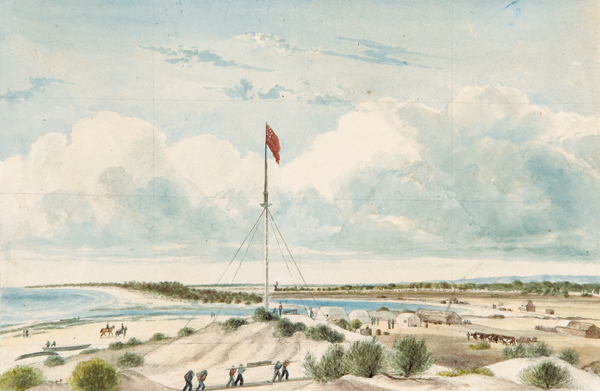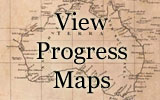In South Australia
Colonel Light is preparing to leave Port Lincoln to return to Gulf St Vincent after satisfying himself that southern Eyre Peninsula is no place for the initial settlement. Once again he battles unsettled weather and strong contrary winds. Luckily he decides to anchor overnight just off Thistle Island, because the morning reveals a reef directly in his path and not marked on Flinders’ charts. ‘[H]ad we been driven from our anchorage in the night’, he writes, ‘we must [all] have perished’. We are reminded that there are perils everywhere, even so close to the final destination. As it is they are spared to proceed on their way, although once again contrary winds prevent their reaching Rapid Bay directly. They run instead for Nepean Bay and there find the Tam O’Shanter recently arrived from England. After a short side trip to Rapid Bay to remove all their belongings, they proceed with the Tam O’Shanter to Holdfast Bay once again.

Light’s diary for 17 December also includes a long explanation of his reasons for preferring Holdfast Bay to Encounter Bay as the site for the settlement. They reflect his long experience as a sea captain and his knowledge of harbours and the economics of mercantile trade, all of which lead him to believe that Encounter Bay is simply too exposed to the southern ocean to provide a safe haven for shipping. He confides these thoughts to Dr Woodforde in Rapid Bay, along with the offer of a further period of engagement as ‘shore going Surgeon’. A relieved Woodforde decides to ignore the pleas of his mother and sister to return to England. ‘[A]s I think there is a chance of my bettering myself here, I think it is right to make a trial.’
At Holdfast Bay the little settlement is settling into a domestic routine. Robert Gouger builds himself a spacious hut of local timber and thatch, the whole held together with ‘{tooltip} cordage {end-text} cords or ropes {end-tooltip}’ and only six nails! Mary Thomas is thankful for her spacious tent, which is large enough to divide into two ‘apartments’. But both complain at length about the plague of insects and other pests that annoy them day and night. Swarms of flies, fleas and mosquitoes nearly drive them mad, while Mary Thomas battles ineffectually against large rats which venture boldly into the tents even in broad daylight. By the end of the week all are afflicted with the painful eye infection known as opthalmia.
The return of the Emma from Kangaroo Island also brings them the sad news that the two missing men cannot be found. No-one can quite discover why the group separated, but rumours of an argument are prevalent. Mary Thomas has the ‘painful task’ of advising young Osborne’s father of his fate, and she approaches the task with great sensitivity, arranging for their agent in London to break the news to him in person and ‘by degrees’. It is a melancholy week for all in the settlement.
At sea
As all in the settlement watch eagerly for the long-anticipated arrival of the Governor, the Buffalo continues its stately progress across the ocean. On 11 December it passes Cape Chatham on the coast of Western Australia. George Stevenson is now openly contemptuous of Hindmarsh, as governor and as captain, losing no opportunity to disparage his judgement and his seamanship. Now that they are so close to their destination, Hindmarsh’s slow but steady approach seems to irritate Stevenson even more. He does however have an interesting conversation with a poor Scottish emigrant, whose kindly views on future relations with the Aborigines meet with his approval. In these and other views Stevenson is something of a radical, even while he remains typical of his class in other ways.


Comments or Questions: